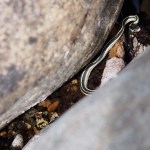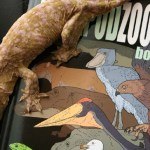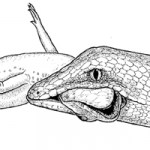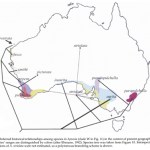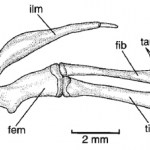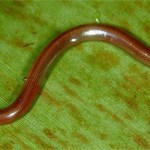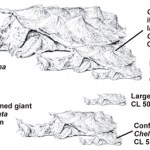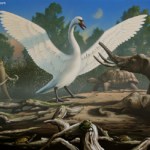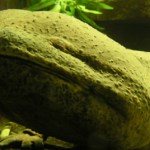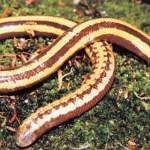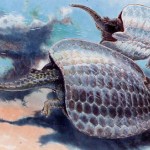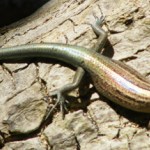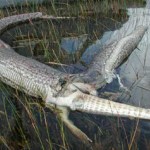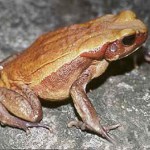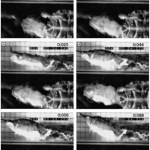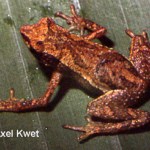herpetology
I found this beautiful snake basking in barely flowing water at an elevation of about 5800' in the Sierra Nevada mountains of California. At first I thought it was a striped racer, but racers have two light stripes on their sides, while this one has a light stripe down the middle of its back and a light underbelly. It appears to be a juvenile garter snake, or at this altitude, it could be full-grown, morphologically adapted to a less plentiful food web. It's rather small, about 24" long. Click any image below for full size.
Light belly, dark back with a single stripe down the middle…
If you didn't know, I've been away. The last four articles that have appeared here were all scheduled to publish in my absence. I've been in Romania and Hungary where I had a great time - saw lots of neat animals (fossil and living) and hung out with some neat people. I'll talk about some of this stuff in due course. For now, here's a really nice picture, kindly provided by artist-animator Ethan Kocak.
Ethan keeps and breeds geckos and, as you can see from this photo of one of Ethan's New Caledonian giant geckos Rhacodactylus leachianus henkeli, it seems that these lizards are big fans of at…
In the previous article I provided brief reviews of all currently recognised pygopodid 'genera'*. Except one. I've left this one until last, largely because it's the most spectacular (up to 75 cm in total length) and (arguably) most fascinating pygopodid. We've seen throughout this series of articles that pygopodids are convergent with certain snake groups, and may in fact have been so successful at filling up ecological niches occupied elsewhere by colubroid snakes that they effectively prevented such snakes from evolving: you can imagine this as the 'pygopodids got there first' hypothesis…
I really want to get these pygopodid articles finished. Actually, I really want to get the whole gekkotan series finished: the end is in sight and I know I'll get there eventually. In the previous articles on pygopodids (part of the long-running series on gekkotan lizards: see links below), we looked at pygopodid diversity and biology in general, and also at the phylogeny and evolutionary history of these fascinating, snake-like gekkotans. This time round, we look in more detail at the various different pygopodid taxa - not on a species-by-species basis (alas), but according to the units we…
The previous article - part of my now lengthy series on gekkotan squamates (see links below) - provided an introduction to the neat and fascinating near-limbless Australasian gekkotans known as the pygopodids. Disclaimer: the group being discussed here is 'Pygopodidae of tradition', not Pygopodidae as currently formulated. More on this matter later.
One topic that I didn't explore fully in the previous article is pygopodid diversity. These reptiles aren't all samey little generalists; species within the group practise several different lifestyles and foraging behaviours, and the amount of…
One of my shortish-term goals at Tet Zoo has been to complete the series on gekkotan lizards I started in April 2010 (see below for links to previous parts). We continue with that series here, and this time round we're going to look at what should definitely be regarded as the weirdest of gekkotans: the near-limbless pygopodids, pygopods or flap-footed lizards, all of which inhabit Australia and New Guinea (and at least some of the surrounding islands). Because there's a lot to say about them, the article you're reading is the first of three. [Excellent paintings below by Alan Male, from…
Dibamids are a weird and very neat group of fossorial, near-limbless squamates that I've long planned to cover at Tet Zoo. Little is known about them and how they might relate to other squamates has long been the subject of debate (they might be close to amphisbaenians, but links with gekkotans, skinks and snakes have all been suggested in the past). I'm going to avoid saying much about them here: I just want to point to the fact that a newly named species - Dibamus dalaiensis Neang et al., 2011 [shown here; image Thy Neang/Flora & Fauna International] - extends their distribution to…
The Matamata is an incredible animal. A morphologically bizarre, highly cryptic, aquatic South American turtle, it's equipped with a super-specialised wide, flattened skull and a host of peculiar features that allow it to engulf fish and other prey in deft acts of rapid suction.
Surprisingly large (up to 1 m long), it has a very long, thick neck, and a proboscis that it uses as a snorkel. But of course you already know all of this because I covered it in depth in a series of articles published here during 2010 (if you need a refresher, see the links given below). My aim in this fifth and…
It's well known that the islands of the Mediterranean were formerly home to an assortment of island endemics, all of which are now extinct. Most of the best known ones are mammals like pygmy elephants, pygmy hippos, pygmy megacerine deer and giant dormice, but there were also large birds, tortoises and lizards. My excellent friend Bob Nicholls of www.paleocreations.com has been kind enough to share this wonderful piece of art, featuring extinct and extant animals of Pleistocene Malta (close-ups below the fold). It's used with permission and is © Robert Nicholls.
One thing I particularly…
Aww, look at that cute little face, those piggy little, opaque eyes, that wrinkled skin. I just know that you want a little refresher on giant salamanders, so - accompanied with new photos taken at the SMNK in Karlsruhe (by Markus Bühler; thanks) - here's a substantially augmented chunk of text that originally appeared here back in January 2008...
Giant salamanders (or cryptobranchids) are grouped with hynobiids (Asiatic salamanders) in the clade Cryptobranchoidea (or Cryptobranchiformes). There are only three extant species: the North American Hellbender Cryptobranchus alleganiensis, the…
I've been ill, and pressing deadlines for book chapters and other projects have kept me busy. An inability to post stuff on Tet Zoo always frustrates me, as there's just so much Tet Zoo-relevant stuff to get through. And, on that note: I must have said on many occasions that there are whole tetrapod groups, consisting of hundreds or even thousands of species, that I've either never mentioned at all, or have only touched on in passing. I aim to get through as many as I can while the going's good, but there are just so many constraints and distractions. Anyway...
Among the many incomplete…
Having written (briefly) about the turtle-like shelled placodont Henodus chelyops, it's as good a time as any to provide some more information. For starters, here's a close-up photo (kindly provided by Markus Bühler) showing one of the grooves in the left lower jaw. These gutter-like structures (reportedly) contained a baleen-like apparatus, possibly used in filter-feeding (for more discussion of this, you'll need to see the previous Henodus article, or Reif & Stein (1999), Rieppel (2002a) or Naish (2004)). If you're struggling to interpret the skull as shown in the photo, anterior is…
Long-time readers will know that I've been planning to cover placodonts - a group of marine, armour-plated Triassic sauropterygian reptiles - for a long, long time. Still haven't gotten round to it (though there is this one picture). But here's something, at least: a piece of text on the weird, fascinating German placodont Henodus. The text is a (slightly modified) excerpt from Naish (2004); most of the discussion on possible feeding behaviour is based on Rieppel's (2002) conclusions.
Henodus chelyops is known only from the Gipskeuper deposit of Tübingen-Lustnau (Carnian, early Upper…
There are about 3800 lizard species living on the planet today; accordingly, it can sometimes be a bit difficult to keep track of them all. Furthermore, new species are described on a very regular basis, and there's little doubt that many more species await discovery. Matty Smith (from New Zealand) recently encountered the lizard you see here while in Tonga, and he's been having trouble identifying it.
Ever one to take on a tetrapod-themed identification challenge, I had a go at identifying it, and I'd be interested in your opinion should you be able to help.
It's clearly a skink (as…
Regular readers will know that I like covering obscure animals... with luck, really obscure animals. The problem with such animals is that nice images hardly ever - sometimes never - exist. When they do exist, they're protected by copyright and are unavailable for use on a blog. I'm therefore eternally grateful when people are able (and kind enough) to send me photos of an obscure animal, and are able to give me permission to use them. Recently, herpetologist Kate Jackson of Whitman College, Washington, was kind enough to provide the photos you see here. Oh. My. God.
It's Bothrolycus ater…
Episode 2 of series 2 of Inside Nature's Giants was devoted to pythons (for an article reviewing ep 1, go here). Specifically, to Burmese pythons Python molurus. And, quite right too. Snakes are among the weirdest and most phenomenally modified of tetrapods: in contrast to we boring tetrapodal tetrapods with our big limb girdles, long limbs and less than 100 vertebrae, we're talking about tubular reptiles with a few hundred vertebrae, stretched organs, distensible jaws and a total or virtual absence of limbs and limb girdles [montage above shows Simon Watt with captive Burmese python (©…
Once more, we return to those wonderful, phenomenally successful, charismatic beasts.... the toads. As you'll know if you've read the previous articles in the toads series, it seems that most basal divergences within crown-Bufonidae happened in South America. So far as we can tell right now, crown-toads are ancestrally South American, and all of their early history happened on this continent [Rhaebo blombergi image below from here].
All of the basal toads looked at so far - the relatively small, slender-limbed, shallow-snouted members of the clades Melanophrynicus, Atelopus, Osornophryne,…
In the previous Matamata article I discussed the very scary skull and hyoid anatomy of this singular South American turtle. The 'ugly' look of the Matamata is well known, but hopefully you now know that the Matamata should also be famous for its large size, for its massively thick, long neck, for its pivotal historical role in our understanding of pleurodire turtle diversity, and for its freakish, flat-faced skull [illustrations above from Patrick Lemell's website].
As you'll no doubt already know, the remarkable morphology of the Matamata's head and neck correlates with a remarkable…
Lest we forget, one of my aims for 2009-2010 is TO GET THROUGH ALL THE TOADS OF THE WORLD. I don't mean every single species (because there... like, over 540 of them), but all the 'genera' at least. If you need any of the background to this grand/crazy scheme, be sure to check out the links below [image below shows Mt Kukenan in the Guyanan Highlands, and a Pebble toad Oreophrynella niger rolling downhill. Read on...].
One of the main points I've emphasised in some of the previous articles is that toads - or, crown-toads, anyway - seem to be ancestrally South American: the redbelly toads (…
Welcome to another article on the Matamata Chelus fimbriatus. Yay!
In the previous episode we looked briefly at the Matamata's long, thick neck and on a few aspects of Matamata evolution (a brief introduction to what the Matamata is, and where it lives, can be found here) [in the composite image shown above, the skull and neck is from digimorph while the photo of the live animal is from wikipedia]. This time, we're going to look at the anatomy of the skull and hyoid skeleton (do stick with me here, it's well worth it). I made the point previously that, despite being comparatively well-…
